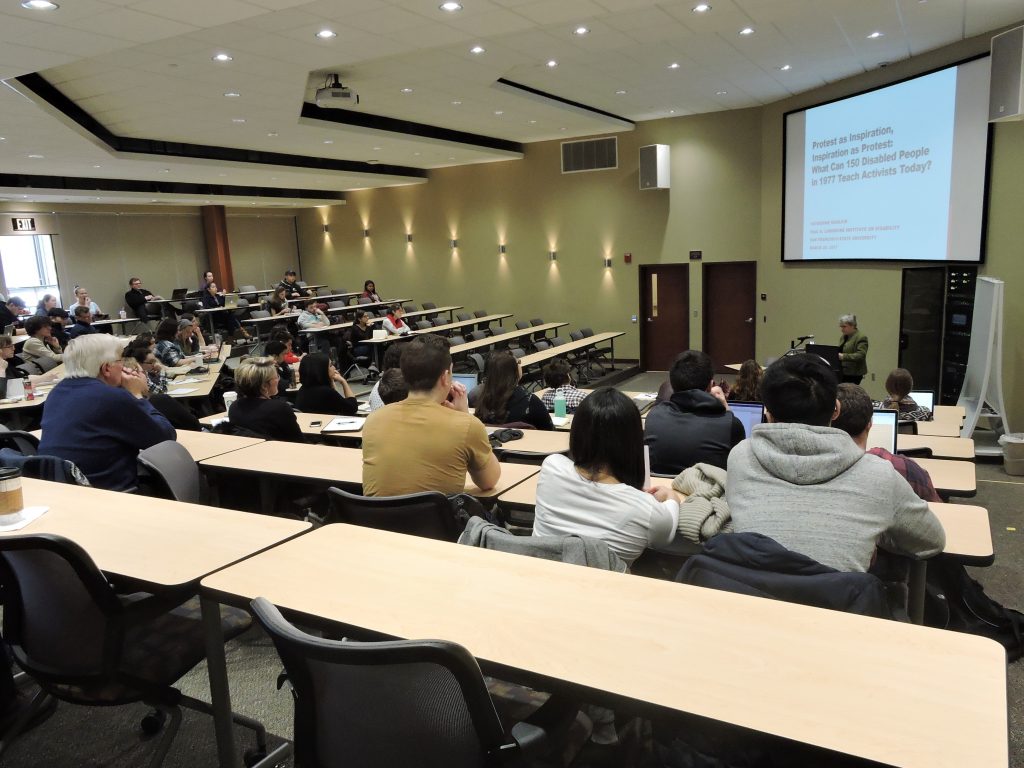
For nearly a month in 1977, the fourth floor of the San Francisco Federal Building was occupied by 150 people with varying disabilities in an effort to get a final signature on a bill to protect disabled people from discrimination and guarantee them equal access to institutions receiving federal funding.
This example of activism was the focus of Binghamton University’s 10th annual Shriber Lecture, held on Monday afternoon in the Center of Excellence’s Symposium Hall in the Innovative Technologies Complex. Catherine Kudlick, a professor at the Paul K. Longmore Institute on Disability at San Francisco State University, delivered the talk, titled “Protest as Inspiration, Inspiration as Protest: What Can 150 Disabled People in 1977 Teach Activists Today?”
The talk was hosted by the history department and endowed by Harvey and Elizabeth Prior Shriber, two Broome County high school teachers whose foundation funds visiting lecturers annually in an effort to bring speakers to BU who can contribute both to the campus and the community. Lectures in recent years have been on peace negotiations in the Civil War and on nomad rulers in history.
More than 100 students and faculty members attended, and Kudlick challenged their conceptions of activism based on the passing of Section 504 of the Rehabilitation Act, the result of the sit-in 40 years ago.
“Right down to the curb cuts on every street corner and the students who fill classrooms, every single one of you was touched by these events, maybe 10 seconds ago,” Kudlick said. “Any wheelchair-accessible classroom you enter is a direct result of what I’m talking about today.”
The protestors, some blind, some deaf, some paraplegic and all of them disabled, stayed for 26 days. They formed a community and built cross-disability interdependence that previously was foreign to the disabled community, according to Kudlick. She described the disabled community as politically awakened from that moment forth.
“The 504 Protest was a success because it had strong conviction inside and strong support outside,” she said. “It was passionate, smart and super embarrassing to public officials.”
Kudlick spoke of the protest’s legacy in launching disability activism and as a precursor to the Occupy movement of 2011, in its lessons on grass-roots activism and protest by occupation. She also spoke of what 504 taught her about activism: It doesn’t require conventions.
Determined to promote story of 504, Kudlick and her colleagues created “Patient No More,” an exhibition highlighting the protest’s history. The exhibition is designed to be completely accommodating for wheelchairs, and also includes audio recordings and “Braille rails” under every piece. It will be on display at the San Francisco Public Main Library in June.
Kudlick said she also challenges her students to contribute Wikipedia articles on lesser-known events in history, like the 504 Protest, in a sort of digital activism that brings underrepresented groups and moments to the forefront. Both the exhibition and writing for Wikipedia, she concluded, are reimagined forms of activism that can reach as far and wide as a monthlong sit-in.
Heather DeHaan, chair of the University’s history department and an associate professor of history, said the history department was excited to invite Kudlick because her work draws attention to how an often overlooked group of people made history.
“It’s important, not only for advancing awareness of [disabled people’s] needs and rights, but also it’s just good history,” DeHaan said.
Samantha Fricke, a junior majoring in psychology, said she agreed that learning about the history of activism is critical.
“It’s important in establishing new activists,” Fricke said. “Especially for people who don’t feel comfortable identifying as an activist in the traditional sense.”


